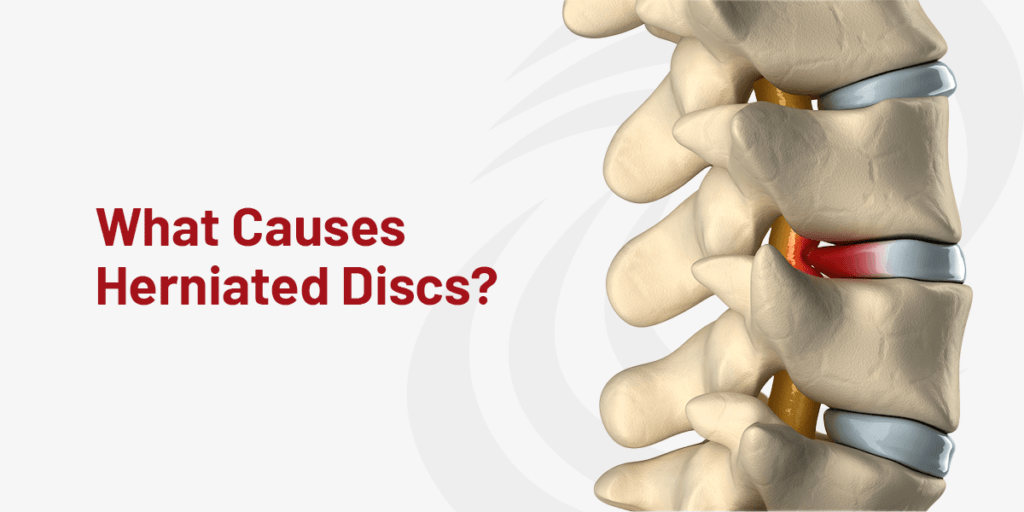
To understand herniated disc causes, you need to know how a healthy spine works. A healthy spine comprises a series of vertebrae and spinal discs. Vertebra provide the structure and protection to the spinal cord. The spinal discs act as mini shock absorbers between the hard bones. They give the spine the flexibility to twist, turn and bend.
There are two parts to a disc. The first is the nucleus pulpous, which is a soft jelly-like center of the disc. The jelly absorbs any impact and gives the spine elasticity. The second part is the annulus fibrosus which surrounds the nucleus pulposus and consists of layers of fibrous tissue arranged in concentric rings. It is tougher and more fibrous than the nucleus pulposus, providing stability to the disc and containing the nucleus pulposus within its confines. The annulus fibrosus also helps distribute pressure evenly across the disc during movement and weight-bearing activities.
Herniated discs are also called slipped or ruptured discs, but they are all the same thing. It is when the nucleus pulpous bulges out through a tear or weakened spot in the annulus fibrosis. This can happen for several reasons, but it often causes the patient severe pain, especially if the herniated disc has compressed any nearby nerves.
Usually, the top of the spine or cervical neck region gets a fair amount of herniated discs, particularly from whiplash patients. The other common area is at the lower lumbar region of the back. The neck and low back sections typically take the most strain when a person picks up heavy objects or gets injured.
Common symptoms include:
A herniated disc could come from one specific incident or develop from several factors. Here are the most common causes of herniated discs:
If you know that your back is a weak area, either due to age or genetics, you can try several things to avoid getting a herniated disc. The strategies focus on maintaining a healthy lifestyle and a healthy spine.
A good posture helps reduce the risk of back and neck pain, minimizing the likelihood of injuring your spine. It can even improve your circulation and digestion. So, what is a good posture? If you are standing, start with your feet about shoulder-width apart.
Now rock a little and distribute your weight evenly between your feet. Keep your knees slightly bent to ease pressure on the lower back. Then, align your head, shoulders and hips. Your ears should be in line with your shoulders. Roll your shoulders a few times. Then, as they roll back, release them.
It isn’t only when you are standing that you should watch your posture. A good posture is also important when you are walking and sitting. When sitting, keep your feet firmly flat on the floor and your knees slightly lower than your hips. If you are working on a computer, keep the screen at eye level so you don’t strain your neck muscles. When you are walking, keep your head level. Try not to look down at your feet too much. Let your arms swing naturally at your sides.
Posture even matters when you sleep. Use pillows or get a mattress that supports your body’s natural curves so you can maintain a good posture while you rest.
When you exercise, focus on your core and back muscles. A general overall tone is ideal. You can achieve this with regular walking or doing yoga and tai chi. Those latter options improve your flexibility and stretch the back, hamstrings and hip flexors. If you want to focus specifically on your core and back, talk to a physical therapist about exercises best suited for you.
They will probably suggest something along the lines of plank exercises, abdominal crunches and pilates. You can focus specifically on the back by doing rowing exercises, using resistance bands and doing pull-ups. A fun exercise is to work on your balance training. You can get a personal trainer or a friend to help you. Work on standing on one leg and using a balance board.
Over time, you will find the exercises you start with might not be as challenging as they used to be. This is because your body is becoming stronger. Ideally, you will want to change your exercises as you progress. Now and then, when you find that what you are doing is getting easy, up the level and do something a little more advanced.
You may have heard before that you should lift with your knees. But how do you do this? You can lift properly by following these easy steps:
If you think you have a herniated disc, reach out to us. We use minimally invasive surgery to relieve pain and discomfort and give you a permanent solution. Because our method only requires a small incision, patients tend to recover faster and have less risk than other practices.
Contact us today, and let’s get your spine healthy again.